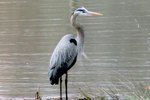
Kingfishers are small to medium-size birds who live close to water and generally fish in the water for their food. Kingfishers' taxonomy is complicated and disputed, but almost 100 kingfisher species are described in places all over the globe. Their long and thick bills, sturdy bodies and colorful feathers make them easily identifiable.
Taxonomy
Until late in the 20th century, kingfishers were considered to be one family. A study by Sibley and Monroe in 1990 utilized DNA evidence to suggest that kingfishers should be divided into three families: river kingfishers, who live near and fish in rivers and streams; water kingfishers, who live around lakes, ponds and marshes; and tree kingfishers, who are more likely than other species to eat insects and arthropods. Some experts, however, disagree that these are distinct and separate families.
Feeding
As their name suggests, kingfishers diets are predominantly made up of fish. They eat other creatures such as insects, frogs, snails and crabs. To hunt, kingfishers find a convenient perch over the water from which they can look out for suitable prey. When they spot something, they swoop down and grab it in their beak. Kingfishers without suitable perches have been known to hover over the water watching for food.
Size
Kingfisher size varies according to species, but most are generally relatively small birds. The world's smallest kingfisher species is the African dwarf kingfisher, which is only 4 inches long and weighs around a third of an ounce. The largest species is the giant kingfisher, which is around 18 inches long and weighs in at an average of 13 ounces.
Habitat
Different species of kingfisher have different habitats, but they generally live near bodies of water, such as rivers, lakes, marshes or sea coast, as natural estuaries are their main source of food. Kingfishers are territorial; when they find a good area in which to live -- with abundant food, nice perches and secure places to roost -- they defend it aggressively from other kingfishers.
Breeding
Kingfishers are usually solitary birds until they pair up for breeding season. They don't build conventional nests; rather, they nest in hollow trees or in burrows they dig themselves, often in riverbanks or lakesides. These burrows are usually 3 to 6 feet long and have nesting chambers at the end. Females can lay up to 10 eggs per clutch. The male and female take turns incubating the eggs for three to four weeks until they hatch.
References
Photo Credits
-
John Foxx/Stockbyte/Getty Images


